OPAXO
Bovino Milenario
- Desde
- 28 Nov 2007
- Mensajes
- 1.156
- Tema Autor
- #1
[h=1]Como cuentan las cronicas, Hitler era un artista frustrado que migro de Autria para buscarse un mejor futuro en Munich, Alemania. Que profesor, al ver sus pinturas, hubiera imaginado la clase de persona que Hitler seria y como marcaria a la humanidad entera. Hoy día parece que el sueño de este paranoico se ha hecho realidad y sus pinturas pasan a ser parte de una subasta. Ni el mismo Hitler, en sus paranoias mas insulsas, habria imaginado que su legado como artista perduraria más que su tercer reich.
Face of a monster: Self-portrait of Hitler painted when he was just 21 revealed at auction[/h]
http://www.dailymail.co.uk/news/art...-Hitler-painted-just-21-revealed-auction.html
By David Wilkes
Last updated at 7:20 PM on 25th March 2009
A solitary figure sits on a bridge, dreaming no doubt of one day invading Poland.
This watercolour is thought to be the earliest self-portrait by Adolf Hitler, painted in 1910 when the future Fuhrer was 21 and a struggling artist.
Kept in storage since it was discovered during the Second World War, it has been placed on public view before it is auctioned next month.
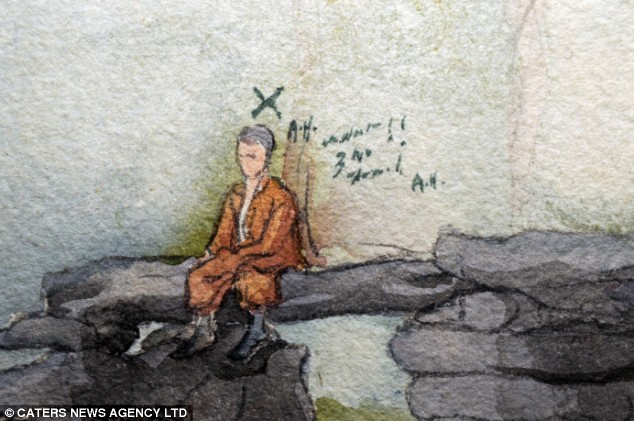 Monster: The unmistakable hair parting shows this is Hitler sitting on the old stone bridge
Monster: The unmistakable hair parting shows this is Hitler sitting on the old stone bridge
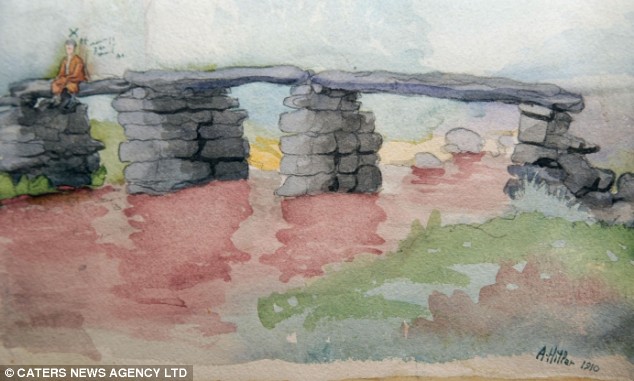 Wider view: The full painting from Hitler showing his signature in the bottom right corner of the painting
Wider view: The full painting from Hitler showing his signature in the bottom right corner of the painting
The painting, along with 12 others by the Nazi monster, was found by Company Sergeant Major Willie J McKenna when he was stationed in Essen, Germany in 1945.
They were sold direct to the present unidentified vendor and kept out of sight for decades.
The small portrait has no nose or mouth, let alone a postage-stamp moustache. But it appears Hitler was keen to identify himself by daubing a cross and the initials AH above the figure.
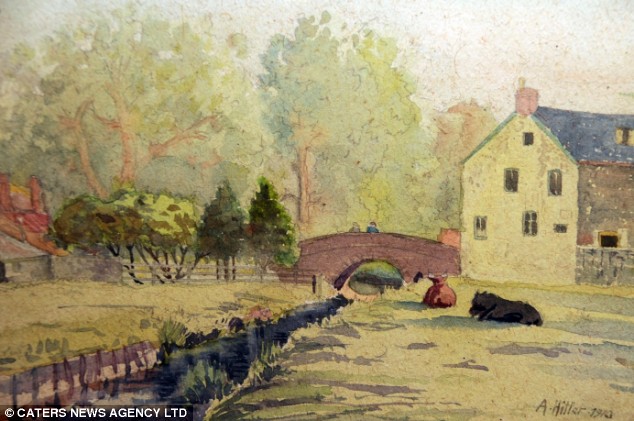 Amateurish: Hitler was rejected twice by the Academy of Fine Arts Vienna in 1907 and 1908
Amateurish: Hitler was rejected twice by the Academy of Fine Arts Vienna in 1907 and 1908
 Landscape: This is one of 13 paintings by the dictator to go on sale at auction
Landscape: This is one of 13 paintings by the dictator to go on sale at auction
The 13 paintings will be auctioned at Ludlow racecourse in Shropshire on April 23 and are expected to fetch tens of thousands of pounds. The others are of flowers and landscapes.
Richard Westwood- Brookes, Mullocks auctioneers' historical documents expert, said: 'It's curious to say the least how an artist, whose interests at this stage of his life should be in such peaceful and bucolic subjects, could turn into the monster he became in later life.
'There's absolutely nothing here to suggest how his mind could have turned in such a way.'
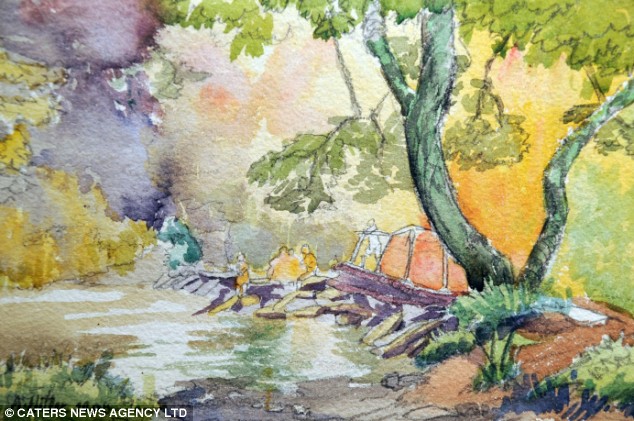 For sale: A 1926 pencil sketch by Hitler was bought by a British buyer for £1,050 in 1999
For sale: A 1926 pencil sketch by Hitler was bought by a British buyer for £1,050 in 1999
He added: 'One can see why Hitler didn't exactly make a success of his career as an artist.
'These are at best the standard of a reasonably competent amateur and some might consider them downright crude in execution.
Saying that, there is a tremendous fascination in Hitler these days and this sale will provide bidders with a rare opportunity of obtaining a work by Hitler at a time long before he started his campaigns of mass murder and world domination.'
Hitler was rejected twice by Vienna's Academy of Fine Arts in 1907 and 1908 after being told he was not a talented enough artist.
He resorted to copying scenes from postcards and selling them to tourists.
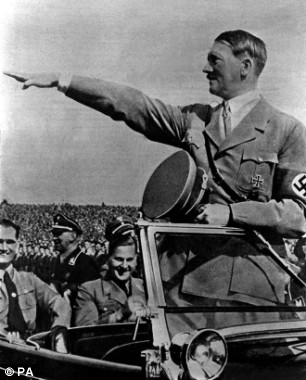
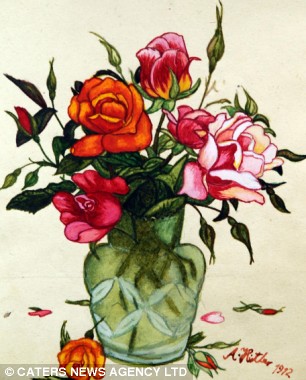
The two sides of Hitler: The Fuhrer greeting the masses - and his painting of a bunch of flowers
Read more: http://www.dailymail.co.uk/news/art...d-just-21-revealed-auction.html#ixzz1kb4bhsjP
[h=2]Subastan en Internet cuadro pintado por Hitler en su juventud
[/h] Cultura • 26 Enero 2012 - 1:28pm — EFE Se trata de la obra "Paisaje marino nocturno", pintado en 1913, aparece la luna entre nubes y su reflejo rielando en el mar, el precio de salida es de 13 mil dólares.
Praga • Un cuadro pintado por Adolf Hitler en su juventud ha sido puesto a la venta por una casa de subastas eslovaca en su página web con un precio de salida de 13 mil dólares.
En "Paisaje marino nocturno", pintado en 1913, aparece la luna entre nubes y su reflejo rielando en el mar, informaron hoy varios diarios locales.
"Todos le conocemos como un déspota. Entonces no barruntaba que se convertiría en uno de ellos. Quería ser artista", dijo al diario CAS Jaroslav Krajcak, el dueño de la agencia de subastas "Darte".
Krajcak aseguró que obtuvo el cuadro de la familia de una coleccionista eslovaca, que la adquirió en la época de la Primera República Checoslovaca (1918-1938).
Después de la Segunda Guerra Mundial la propietaria no estaba conforme con el cuadro y sus sucesores querían deshacerse de él.
"Estas obras llegan al mercado muy raras veces. Los coleccionistas no las venden pues las consideran únicas", agregó.
http://www.milenio.com/cdb/doc/noticias2011/ec8ad0740ac6034d5ab306fa9fec24b0
Face of a monster: Self-portrait of Hitler painted when he was just 21 revealed at auction[/h]
http://www.dailymail.co.uk/news/art...-Hitler-painted-just-21-revealed-auction.html
By David Wilkes
Last updated at 7:20 PM on 25th March 2009
A solitary figure sits on a bridge, dreaming no doubt of one day invading Poland.
This watercolour is thought to be the earliest self-portrait by Adolf Hitler, painted in 1910 when the future Fuhrer was 21 and a struggling artist.
Kept in storage since it was discovered during the Second World War, it has been placed on public view before it is auctioned next month.


The painting, along with 12 others by the Nazi monster, was found by Company Sergeant Major Willie J McKenna when he was stationed in Essen, Germany in 1945.
They were sold direct to the present unidentified vendor and kept out of sight for decades.
The small portrait has no nose or mouth, let alone a postage-stamp moustache. But it appears Hitler was keen to identify himself by daubing a cross and the initials AH above the figure.


The 13 paintings will be auctioned at Ludlow racecourse in Shropshire on April 23 and are expected to fetch tens of thousands of pounds. The others are of flowers and landscapes.
Richard Westwood- Brookes, Mullocks auctioneers' historical documents expert, said: 'It's curious to say the least how an artist, whose interests at this stage of his life should be in such peaceful and bucolic subjects, could turn into the monster he became in later life.
'There's absolutely nothing here to suggest how his mind could have turned in such a way.'

He added: 'One can see why Hitler didn't exactly make a success of his career as an artist.
'These are at best the standard of a reasonably competent amateur and some might consider them downright crude in execution.
Saying that, there is a tremendous fascination in Hitler these days and this sale will provide bidders with a rare opportunity of obtaining a work by Hitler at a time long before he started his campaigns of mass murder and world domination.'
Hitler was rejected twice by Vienna's Academy of Fine Arts in 1907 and 1908 after being told he was not a talented enough artist.
He resorted to copying scenes from postcards and selling them to tourists.


The two sides of Hitler: The Fuhrer greeting the masses - and his painting of a bunch of flowers
Read more: http://www.dailymail.co.uk/news/art...d-just-21-revealed-auction.html#ixzz1kb4bhsjP
[h=2]Subastan en Internet cuadro pintado por Hitler en su juventud
[/h] Cultura • 26 Enero 2012 - 1:28pm — EFE Se trata de la obra "Paisaje marino nocturno", pintado en 1913, aparece la luna entre nubes y su reflejo rielando en el mar, el precio de salida es de 13 mil dólares.
Praga • Un cuadro pintado por Adolf Hitler en su juventud ha sido puesto a la venta por una casa de subastas eslovaca en su página web con un precio de salida de 13 mil dólares.
En "Paisaje marino nocturno", pintado en 1913, aparece la luna entre nubes y su reflejo rielando en el mar, informaron hoy varios diarios locales.
"Todos le conocemos como un déspota. Entonces no barruntaba que se convertiría en uno de ellos. Quería ser artista", dijo al diario CAS Jaroslav Krajcak, el dueño de la agencia de subastas "Darte".
Krajcak aseguró que obtuvo el cuadro de la familia de una coleccionista eslovaca, que la adquirió en la época de la Primera República Checoslovaca (1918-1938).
Después de la Segunda Guerra Mundial la propietaria no estaba conforme con el cuadro y sus sucesores querían deshacerse de él.
"Estas obras llegan al mercado muy raras veces. Los coleccionistas no las venden pues las consideran únicas", agregó.
http://www.milenio.com/cdb/doc/noticias2011/ec8ad0740ac6034d5ab306fa9fec24b0
